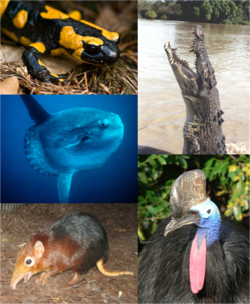
Back Gewerweldes Afrikaans Wirbeltiere ALS ባለ አከርካሪ Amharic Vertebrata AN Hrycgdēor ANG فقاريات Arabic سنسوليات ARY فقاريات ARZ মেৰুদণ্ডী প্ৰাণী Assamese Vertebrata AST
| Vertebrados | ||
|---|---|---|
| Rango temporal: 530 Ma - 0 Ma Cámbrico - Reciente | ||
 Ejemplos de vertebrados: Salamandra de fuego, pez luna, musaraña elefante, cocodrilo marino gigante y casuario sureño | ||
| Taxonomía | ||
| Superreino: | Eukaryota | |
| Reino: | Animalia | |
| Subreino: | Eumetazoa | |
| Superfilo: | Deuterostomia | |
| Filo: | Chordata | |
| Subfilo: |
Vertebrata Cuvier, 1812 | |
| Infrafilo: | Agnatha/Gnathostomata | |
| Clases y clados | ||
Véase el texto | ||
| Sinonimia | ||
| ||
Los vertebrados (Vertebrata) son un subfilo muy diverso de cordados que comprende a los animales con espina dorsal o columna vertebral, compuesta de vértebras. Incluye unas 72 327 especies actuales.[1]
Los vertebrados han logrado adaptarse a diferentes ambientes, incluidos los más difíciles e inhóspitos. Aunque proceden inicialmente del medio dulceacuícola, una gran diversidad de formas evolucionó en el mar y más tarde, en el medio terrestre.
El término «Vertebrata», usado en sentido amplio, es sinónimo de "Craniata", e incluye a los mixinos, que no poseen auténticas vértebras, y a las lampreas, que poseen esbozos de vértebras denominados arcualia, junto a los gnatostomados que por lo general poseen vértebras. Según los estudios genéticos, las lampreas y mixinos forman un grupo llamado Cyclostomi dentro de Vertebrata.[2][3][4][5][6][7] Evidencias fósiles recientes también apoyan la inclusión de los mixinos en los vertebrados, esto sugiere que los mixinos son descendientes de vertebrados sin mandíbula que durante su evolución perdieron las vértebras.[8] Esta agrupación exige excluir a las lampreas del clado Cephalaspidomorphi el cual incluye a los peces sin mandíbulas más emparentados con los gnatostomados.
- ↑ «The IUCN Red List of Threatened Species». IUCN Red List of Threatened Species. Consultado el 6 de mayo de 2020.
- ↑ Kuraku, Shigehiro; Hoshiyama, Daisuke; Katoh, Kazutaka; Suga, Hiroshi; Miyata, Takashi (Diciembre de 1999). «Monophyly of Lampreys and Hagfishes Supported by Nuclear DNA–Coded Genes». Journal of Molecular Evolution 49 (6): 729-735. doi:10.1007/PL00006595.
- ↑ Delabre, Christiane (2002). «Complete Mitochondrial DNA of the Hagfish, Eptatretus burgeri: The Comparative Analysis of Mitochondrial DNA Sequences Strongly Supports the Cyclostome Monophyly». Molecular Phylogenetics and Evolution 22 (2): 184-192. PMID 11820840. doi:10.1006/mpev.2001.1045.
- ↑ Stock, David; Whitt GS (7 de agosto de 1992). «Evidence from 18S ribosomal RNA sequences that lampreys and hagfishes form a natural group». Science 257 (5071): 787-9. PMID 1496398. doi:10.1126/science.1496398.
- ↑ Kuraku et al. (diciembre de 1999). «Monophyly of Lampreys and Hagfishes Supported by Nuclear DNA–Coded Genes». Journal of Molecular Evolution doi 10.1007/PL00006595.
- ↑ Kuraku, Shigehiro; Meyer, Axel; Kuratani, Shigeru (2009a). «Timing of Genome Duplications Relative to the Origin of the Vertebrates: Did Cyclostomes Diverge before, or after?». Molecular Biology and Evolution 26 (1): 47-59. PMID 18842688. doi:10.1093/molbev/msn222.
- ↑ Heimberg, Alysha M.; Cowper-Sallari, Richard; Sémon, Marie; Donoghue, Philip C. J.; Peterson, Kevin J. (9 de noviembre de 2010). «microRNAs reveal the interrelationships of hagfish, lampreys, and gnathostomes and the nature of the ancestral vertebrate». PNAS 107 (45): 19379-19383. PMC 2984222. PMID 20959416. doi:10.1073/pnas.1010350107.
- ↑ Tetsuto Miyashita, Michael I. Coates, Robert Farrar, Peter Larson, Phillip L. Manning, Roy A. Wogelius, Nicholas P. Edwards, Jennifer Anné, Uwe Bergmann, Richard Palmer, Philip J. Currie, (2019). Hagfish from the Cretaceous Tethys Sea and a reconciliation of the morphological–molecular conflict in early vertebrate phylogeny. PNAS.